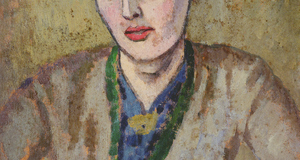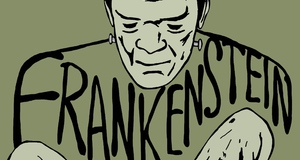From Comrades to Lovers: "The Hollow Men" and the Broken Homosocial Spectrum
By
2009, Vol. 1 No. 11 | pg. 1/2 | »
KEYWORDS:
In Between Men: English Literature and Male Homosocial Desire, Eve Sedgwick proposes the idea that not only women, but also men, can travel along a social spectrum that ranges from friends to lovers. However, she argues that the male homosocial spectrum is broken up by male homophobia in society. This is illustrated in various literature, from works by openly gay authors to stories and poems by writers who are either straight or of a questionable orientation (Sedgwick). One such work is T.S. Eliot’s “The Hollow Men,” in which the poem’s speaker uses word choice and imagery to travel along the homosocial spectrum, complete with rifts caused by both society and religion forming tensions between their desires and what is seen as socially acceptable. The speaker of the poem follows a fairly linear path from comrade to lover through the five sections of the poem. His relationship begins with men who are participants in a failed revolution, given the connection with Guy Fawkes in the line “A penny for the old Guy” (Eliot section 0: line 1). Fawkes tried to stir a revolution in England by igniting barrels of gunpowder under Parliament while the lords were in session, thus causing an end to their religious oppression. The monarchy caught them, and Guy and his co-conspirators were imprisoned, tortured, and executed (The Gunpowder Plot). In relation to this revolution, the speaker in the first section of the poem talks about the characters “Leaning together,” (Eliot 1:3) and they “whisper together,” (1:6) offering support and friendship to each other in this time of failure and strife. The next reference to their relationship is in section three where they are “Trembling with tenderness” (3:11), with “Lips that would kiss,” (3:12) which are instead praying and not fulfilling their desire. In section four, they “grope together” (4:19), a word which Oxford English dictionary defines as “To touch with the hands…to handle, feel…in indecent sense,” (Oxford grope:3b).This steadily increasing sexuality comes to a peak in section five in which three different devices in the poem work together to suggest intercourse. First of these is the imagery used in the nursery rhyme which starts the section. Originally the nursery rhyme went “Here we go round the mulberry bush / Mulberry bush mulberry bush / Here we go round the mulberry bush / So early in the morning,” (Wakefield). Eliot substitutes a prickly pear for the mulberry bush and for the last line, “At five o’clock in the morning” (Eliot 5:4). The substitution of “prickly pear,” (5:1) for “mulberry bush” may be an effort to change the connotations of the rhyme. Mulberry bushes stood for love and all items associated with it whereas the prickly pear is more of a phallic symbol, representative of manliness and sexuality (Smith). Also of a sexual nature, the reference to five o’clock in the morning refers to the ritual during May Day celebrations of collecting nuts in the woods at five o’clock in the morning. May Day is a notoriously sexual holiday celebrating fertility and life. As such, this referencing of a ritual which placed young men and women in the woods alone on a day of promiscuity adds to the sexual overtures which start this section (Smith). The second aspect of this section which promotes the idea of sexuality is the word choice in stanzas two through four. For example, “Emotion” (5:13), such as love or lust, can lead to a response (5:14), which is sex. The “desire” (5:17), or lust for that which is not yet attained, as in sexual desire, can lead to the “spasm” (5:18), or the muscle contractions which accompany an orgasm in a man’s penis. This stanza ends with the pairing of “essence” (5:21) and “descent” (5:22). Essence is “An extract obtained by distillation” (Oxford essence:9a) which could be a reference to ejaculation. There were times in history in which a man’s semen is thought to be the life force of the man, distilled into a transferable form to be passed into the woman to start new life (Bynum, 227). As Caroline Bynum states, historically, “the father’s body concocts a seed with vital spirits, which in some sense engenders spirits…but one thing is clear: the line between soul and body, form and matter, disappears in a complex apparatus that obscures the transition point from one to the other” (Bynum, 227). This is why certain religions, such as Judaism, frown upon masturbation and other religions frown upon protected sex or gay sex, because it is a waste of a part of the man which is earmarked for procreation. The descent in this section can refer to the release of hormones and the reduction of an erection once the man reaches orgasm. When related to these two stanzas, the words in stanza two take on a more sexual nature, for example the “idea” (Eliot 5:5) of sex and the “reality” (5:6). A man may have an idea about homosexuality, but in most sects of Christianity, it only becomes sinful when it is acted upon in either thought or deed and thus becomes “real.” In the same way, a simple movement of an arm may be just that, movement, but as soon as it caresses the arm of another man it becomes a definite act. Emphasizing this word choice and the imagery which begins section five, the rhythm of this section represents both the motion of sex and the interruptions caused by the homophobia of society and religion. First, there is no punctuation from the beginning of stanza two until the end of the poem. This allows for increasing speed to carry the reader through the poem, just as speed increases during intercourse. In stanza five, this increasing rhythm is accompanied by a breaking up of phrases, a fragmenting of thought, until there is an abrupt transition back to the sing-song rhythm which starts the section. This can be seen as a representation of those last few moments before orgasm in which breathing becomes erratic followed by a return to normalcy. This whole sexual section is deliberately broken up into segments; it is not allowed to continue un-abated. There are three interjections between stanzas which halt the rhythm and bring attention to themselves. Those lines are “For Thine is the Kingdom,” (5:10 and 5:24) and “Life is very long” (5:16). This is an example of religion stepping in and interrupting this relationship. At the end of stanzas two through five, the shadow comes between everything. This is a reference to the shadow of death from Psalm 23 which talks about “the shadow of death,” (Bible). This religiously significant shadow comes between items like the “emotion” (5:13) and the “response” (5:14) and halts the men before they respond to their feelings. This combination of saying the Lord’s Prayer (For Thine is the Kingdom) and the psalm create these images of religion. Religion also appears in section three when “Lips that would kiss / Form prayers to broken stone” (3:12,13). This is a reference to a story in the Old Testament of the worship of Ba’al. In Numbers 25 (Bible) there is a story of Jews who were swayed from the right path to worshipping Ba’al with several sexually immoral Moabite women. These men and women were destroyed for their idolatry. The immorality the men conducted with the Moabite women (“Lips that would kiss” (Eliot 3:12)) led to those same lips uttering prayers to the stone pillar that traditionally represented Ba’al, which was metaphorically broken when they were put to death for worshipping a false idol and sexual immorality. So religion is again stepping between sexual desire and its fulfillment. Religion can also be seen as a replacement for their “inappropriate” feelings towards each other. Bynum suggests that at times, sexual desire is transformed into piety or religious ecstasy (Bynum, 133). The lines saying over and over “For thine is the kingdom” (Eliot 5) are evidence that the men are trying to stem their feeling through religion by praying. It is common to pray when one feels that they are going to sin to ask for strength and such. This form prayer which is likely to be recognizable to most readers is Eliot’s way of letting the reader know that the men are trying to bring their “wayward” emotions under control. However, religion isn’t the only obstacle between these men and their love.Continued on Next Page » Suggested Reading from Inquiries Journal
Inquiries Journal provides undergraduate and graduate students around the world a platform for the wide dissemination of academic work over a range of core disciplines. Representing the work of students from hundreds of institutions around the globe, Inquiries Journal's large database of academic articles is completely free. Learn more | Blog | Submit Latest in Literature |


















